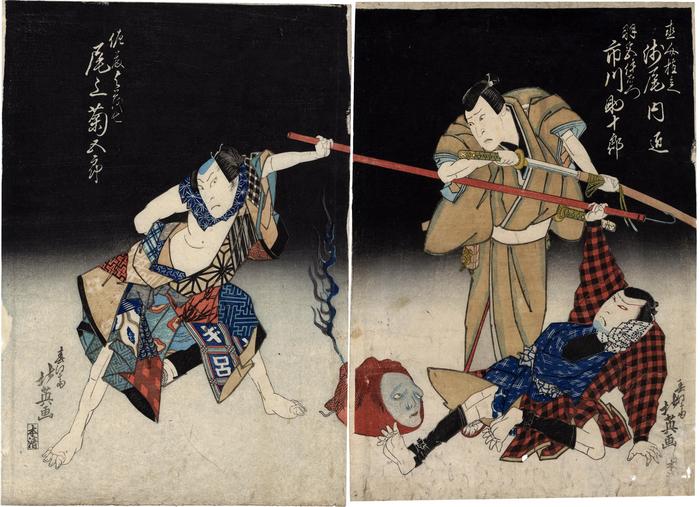Shunbaisai Hokuei (春梅斎北英) (artist )
Asao Takumi I (浅尾内匠) as Naosuke Gonbei (直介権兵へ) and Ichikawa Sukejūrō IV (市川助十郎) as Hamiya Iemon (羽宮伊右衛門) on the right, and Onoe Kikugorō III (尾上菊五郎) as Satō Yomoshichi (佐藤与茂七) on the left in the play 'Ghost Story along the Eastern Sea Road at Yotsuya' (Azumakaido Yotsuya Kaidan 東海道四谷怪談)
03/1831
10.5 in x 15 in (Overall dimensions) Japanese color woodblock print
Signed: Shunbaisai Hokuei ga
春梅斎北英画
Publisher: Honya Seishichi (Marks 123 - seal 25-527)
Museum of Fine Arts, Boston
Lyon Collection - another copy of the right sheet
Hankyu Culture Foundation - right panel
Hankyu Culture Foundation - left panel
Hankyu Culture Foundation - fascinating 1831 Kunisada print like the right panel
Victoria and Albert Museum - left panel only
Victoria and Albert Museum - right panel only
National Museum of Asian Art This play was performed at the Wakadayu Theater in Osaka in 3/1831.
***
Osaka Prints writes of this diptych:
Background
Tōkaidō [Azumakaidō] Yotsuya kaidan (Ghost story along the eastern sea road at Yotsuya: 東海道四谷怪談) is the most popular of all kabuki ghost plays, an 1825 masterpiece by the playwright Tsuruya Nanboku IV. (An alternate reading of Tōkaidō would be Azumakaidō.) It is one of many kaidan mono (ghost plays: 怪談物) in kabuki, and a very popular theme in popular literature and song.
Oiwa's husband Iemon — a down-on-his-luck rōnin (lit., "wave man" or masterless samurai: 浪人) reduced to making oil-paper umbrellas — despairs over his ill fortune, made worse by Oiwa, who is struggling in her postpartum convalescence and nursing a newborn child. He finds temptation in a neighbor's young daughter named Oume, and is persuaded by her grandfather to give Oiwa a "medicinal potion" — actually a poison — meant to disfigure her so that Iemon will divorce her. Oiwa drinks the potion and her face takes on a monstrous countenance. Soon after, she dies in an accident brought on by jealousy and rage. Her ghost relentlessly haunts Iemon, tracking him down in a hermitage at Hebiyama ("Snake Mountain") where he is taking refuge. He is finally slain by another rōnin helped by the sister of a servant he has murdered.
Design
In this scene, Oiwa's ghost returns to haunt and take revenge on Iemon, but the ghost is decapitated. Even so, her severed head, positioned eerily between the antagonists, still manipulates Iemon's companions into attacking him.
Obake-e (lit., "transformed thing," in this instance ghost prints: お化け絵) are relatively uncommon in Osaka printmaking, compared with Edo prints. Hokuei's diptych distills the essence of what kabuki audiences looked for in their kaidan mono: A mood of terror (note that the actors are set against a pitch-black sky), a gruesome stage prop (Oiwa's head), and an otherwise lack of contextual detail so as to concentrate on the figures and the otherwordly shinka (spirit flame: 神火), symbolic of a supernatural presence. Altogether, this is a fine ghost print by Hokuei.
****
The curatorial notes at the National Museum of Asian Art say: "In performances of Ghost Story of Yotsuya on the Tōkaidō, the same actor plays the roles of Oiwa, Kohei, and Oiwa’s brother-in-law, Satō Yomoshichi. Here, Yomoshichi confronts the villain Iemon and his crony Gonbei, while Oiwa’s disembodied head lies in the center. The use of a dummy head allowed both Oiwa and Yomoshichito appear onstage at the same time. In the final scene, the ghost of Oiwa assists Yomoshichi in killing Iemon. The audience is aware that the same actor is playing multiple roles, giving greater significance to Yomoshichi’s actions."
****
Illustrated in:
1) Bosuton bijutsukan shozō Kamigata-e mokuroku, Kitagawa, Kansai daigaku, 2007, p. 99.
2) Ikeda Bunko, Kamigata yakusha-e shūsei (Collected Kamigata Actor Prints), vol. 3, Osaka, 2001, no 563.
3) in color in Hokuei: Master of Osaka Kabuki Prints by John Fiorillo, Ludion, 2024, cat. 31, page 41. There is also a smaller color reproduction on page 145 with extra information. The author wrote on page 40: "The medicine seller Naosuke Gonbei, shown standing on the right sheet, lusts after Osode, Oiwa's sister and the wife of Satō Yomoshichi. Between Naosuke and Iemon on the right and Satō on the left lies the severed head of Oiwa's ghost and her spirit flame."
Fiorillo writes in a footnote: "Playbills for the 1825 premiere show the first character in the title as "Azuma," not To. Satoko Shimazaki has pointed out that Yotsuya is not on the Tōkaidō highway, rather on the Kōshūkaidō and that Azuma might allude to the trip Kikugorō III was about to make to Dazaifu on the Tōkaidō. Another theory is that the title was actually read as Azumakaidō, a reference to the Ako retainers "eastward travels" (Azuma kudari), and some playbills from the first performance have this reading. See Satako [sic] Shimazaki "The Ghost Oiwa in Actor Prints: Confronting Disfigurement." Impressions 29 (2008): 95. Furthermore, the connections to the infamous Aki incident and associated play Copybook of the Treasury of Loyal Retainers (Kanadehon chūshingura) is supported by the backstories for the roles of Hamiya Iemon and Satō Yomoshichi, both of whom are identified as former samurai serving Enya Hangan, whose suicide sets off the famous revenge tale in the Chūshingura."
Honya Seishichi (本屋清七) (publisher)
Ichikawa Sukejūrō IV (四代目市川助寿郎) (actor)
Onoe Kikugorō III (三代目尾上菊五郎: 11/1815-3/1848) (actor)
Kyōto-Osaka prints (kamigata-e - 上方絵) (genre)
actor prints (yakusha-e - 役者絵) (genre)
Yūrei-zu (幽霊図 - ghosts demons monsters and spirits) (genre)
Asao Takumi I (初代浅尾内匠) (actor)
Oiwa (お岩) (role)
Tsuruya Nanboku IV (四代目鶴屋南北) (author)
Chūshingura (忠臣蔵 - 47 Rōnin) (genre)
